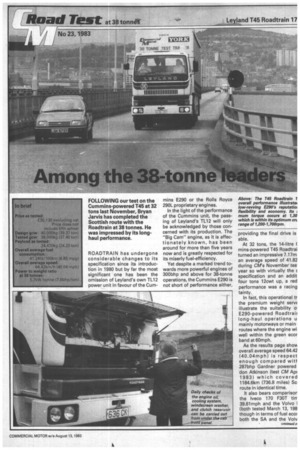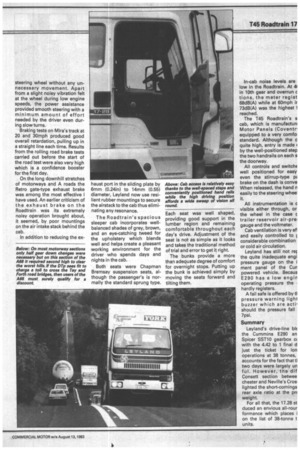Amon the 38-tonn
Page 43

Page 44

Page 45

If you've noticed an error in this article please click here to report it so we can fix it.
FOLLOWING our test on the Cummins-powered 145 at 32 tons last November, Bryan Jarvis has completed the Scottish route with the Roadtrain at 38 tonnes. He was impressed by its longhaul performance.
ROADTRAIN has undergone considerable changes to its specification since its introduction in 1980 but by far the most significant one has been the omission of Leyland's own TL12 power unit in favour of the Cum mins E290 or the Rolls Royce 290L proprietary engines.
In the light of the performance of the Cummins unit, the passing of Leyland's 1112 will only be acknowledged by those concerned with its production. The "Big Cam" engine, as it is affectionately known, has been around for more than five years now and is greatly respected for its miserly fuel-efficiency.
Yet despite a marked trend towards more powerful engines of 300bhp and above for 38-tonne operations, the Cummins E290 is not short of performance either, providing the final drive is able.
At 32 tons, the 14-litre mins-powered T45 Roadtrai turned an impressive 7.17m an average speed of 41.82 during CM's November tes. year so with virtually the e specification and an addit four tons 12cwt up, a red performance was a racing tainty.
In fact, this operational tr the premium weight serve illustrate the suitability ol E290-powered Roadtraii long-haul operations u mainly motorways or main routes where the engine wi well within the green ecor band at 60mph.
As the results page sholn overall average speed 64.42 (4 0.04mph) is respect enough compared witf 287bhp Gardner powered don Atkinson (test CM Apr 1 9 8 3) which covered 1184.6km (736.8 miles) Sc. route in identical time.
It also bears comparisor the Iveco 170 F3OT tirr 39.61mph and the Volvo I (both tested March 13, 198 though in terms of fuel ecor both the SA and the Volv
turned marginally better figures. of 7.00 and 6.86mpg respectively.
Its overall performance amply illustrated the E290's reputation for driveability. For example, on the long M6 sections the 60mph limit could be held for long periods with only the climb along Shap flexing the engine towards its limit.
The gradient also allowed it to demonstrate its ability to lug down below 1200rpm yet still produce a near maximum torque, before necessitating half gear changes.
Where the performance was more than a little suspect was in tackling the severe gradients along the A68 between Jedburgh and Neville's Cross. On the steepest hills, rapid loss of momentum could only be reduced by down shifting early, missing gears in order to find the right gear quickly yet maintain fairly high engine revs.
In particular, Kilnpit Hill and Blackh ill caused me to speculate on the advisability of using this particular final drive ratio of 4.43 to 1 over these hills. The 4.82 to 1 axle ratio offered by Leyland would clearly be a more practical option to exercise for an operator whose activities includes these sort of routes.
The fairly close ratios of the Spicer SST10 gearbox certainly suited the rest of the route where, by using the splitter, down changes could be made quite quickly. Gear shift engagement was always smooth and positive, helped to some extent by the fairly light clutch movement and integral clutch brake.
Although the extra weight had an adverse effect on some aspects of the Roadtrain's performance, any effect on the ride and handling was sca rely noticeable. On some of the twisting and undulating roads south of Edinburgh down to the Borders region its tapered leaf springs, torsion bars and telescopic dampers contributed towards a firm and well controlled ride. Even the difficult run down to Shottley Bridge from the A68 with its choppy road surface and adverse camber failed to cause any problems.
On sharp turns or when negotiating roundabouts there was no hint at the slight roll experienced on the CM test at 32 tons which is probably a consequence of running at the higher weight.
The Cam Gears powered steering handled these difficult sections very smoothly too, giving just the right amount of reactive feel, back through to the steering wheel without any unnecessary movement. Apart from a slight noisy vibration felt at the wheel during low engine speeds, the power assistance provided smooth steering with a minimum amount of effort needed by the driver even during slow turns.
Braking tests on Mira's track at 20 and 30mph produced good overall retardation, pulling up in a straight line each time. Results from the rolling road brake tests carried out before the start of the road test were also very high which is a confidence booster for the first day.
On the long downhill stretches of motorways and A roads the Retro gate-type exhaust brake was among the most effective I have used. An earlier criticism of the exhaust brake on the Roadtrain was its extremely noisy operation brought about, it seemed, by poor mountings on the air intake stack behind the cab.
In addition to reducing the ex haust port in the sliding plate by 6mm (0.24in) to 14mm (0.55) diameter, Leyland now use resilient rubber mountings to secure the airstack to the cab thus eliminating any resonance.
The Roadtrain's spacious sleeper cab incorporates wellbalanced shades of grey, brown, and an eye-catching tweed for the upholstery which blends well and helps create a pleasant working environment for the driver who spends days and nights in the cab.
Both seats were Chapman Bremsay suspension seats, although the passenger's is normally the standard sprung type. Each seat was well shaped, providing good support in the lumbar region and remaining comfortable throughout each day's drive. Adjustment of the seat is not as simple as it looks and takes the traditional method of trial and error to get it right.
The bunks provide a more than adequate degree of comfort for overnight stops. Putting up • the bunk is achieved simply by moving the seats forward and tilting them. In-cab noise levels are low in the Roadtrain. At 41 in 10th gear and overrun c tions, the meter regist 68d8(A) while at 60mph ir 73cIB(A) was the highest I reached.
The T45 Roadtrain's s cab, which is manufactun Motor Panels (Coventri equipped to a very comfo: standard. Although the c quite high, entry is made by the well-positioned step the two handrails on each s the doorway.
All controls and switchE well positioned for easy even the stirrup-type pE brake on the dash is conve When released, the hand n easily to the steering whee. It.
All instrumentation is c visible either through, or the wheel in the case c trailer reservoir air-pre: gauge and the voltmeter.
Cab ventilation is very efi and easily controlled to E considerable combination or cold air circulation.
Leyland has still not re the quite inadequate engi pressure gauge on the i ment panel of the Cun powered vehicle. Becaus E290 has a low engin operating pressure the hardly registers.
A fail safe is offered by ti pressure warning light buzzer which are acti, should the pressure fall 7psi.
Summary Leyland's drive-line blE the Cummins E290 an Spicer SST10 gearbox cE with the 4.42 to 1 final d just the ticket for Ion operations at 38 tonnes, accounts for the fact that tl two days were largely un ful. However, the dif Consett section betwee chester and Neville's Cros: lighted the short-comings rear axle ratio at the pr( weight.
For all that, the 17.28 St duced an envious all-rour formance which places i on the list of 38-tonne t units.
















































































